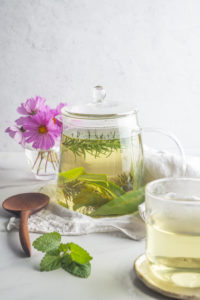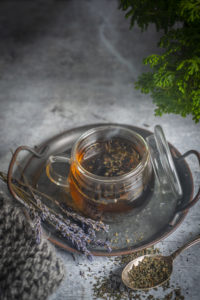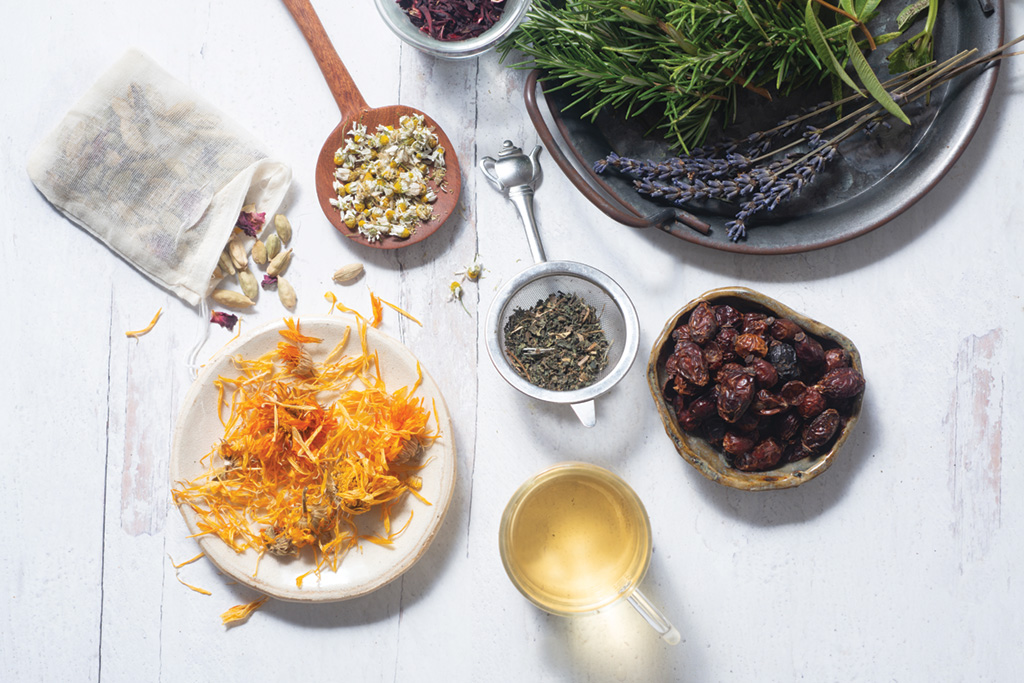The history of tea dates back thousands of years and is deeply embedded in cultures from China to India and Japan to England. Botanists can trace the origin of the tea plant, Camellia sinensis, to an area in southwest China that borders Tibet and northeast India, which fortuitously, was a key area along the Silk Road as the route traveled south toward the maritime Spice Route from the East to the West. Legend states that the drink was discovered by Emperor Shennon sometime around 2737 BC when a few leaves were blown into his bowl of boiled water, changing the color and taste.
The medicinal and healing properties of tea also date back thousands of years. The first known early work on tea by writer Lu Yu in the Tang Dynasty, The Classic of Tea, written about 760 CE, tells how the leaves, stems and roots of various plants were chewed to discover their medicinal properties, and tea was found to work as an antidote. The Greek physician Dioscorides also wrote about the potential benefits of hundreds of herbs when steeped in the form infusions and the Greek word ptisanē (from ptissein, to crush, and referencing a medicinal drink made from barley-soaked water) is the root etymology for the word tisane and referenced.
 In North America, various types of tisanes were used by indigenous tribes for their healing properties. When European settlers arrived in America, it was the indigenous people that taught them to make pine needle tea, which are an excellent source of Vitamin C, to help cure their scurvy.
In North America, various types of tisanes were used by indigenous tribes for their healing properties. When European settlers arrived in America, it was the indigenous people that taught them to make pine needle tea, which are an excellent source of Vitamin C, to help cure their scurvy.
Today more than ever, consumers are turning to healthier food and drink choices in an effort to boost immunity and stay healthy. As demand grows for wellness, plant-based foods and drinks are trending higher, and teas and tisanes are among the buzz.
One of the simplest and oldest way to harness the power of plants is by infusing them into water to make an herbal tea. The use of tea for medicinal benefits, relaxation and ceremonial celebrations has a long history circling the globe. Tea is a versatile drink, with distinct tea cultures surrounding each cup. Many wake to a morning cup to stimulate digestion, afternoon tea is a British custom, and other tea enthusiasts wouldn’t think of finishing a meal without it. Harnessing the power of plants by making your own creative blends is a simple self-care act that can be enjoyed throughout the seasons and at any time of the day.
Sun Valley Magazine turned to national award-winning food photographer and self-proclaimed foodie, Paulette Phlipot, for some insight into teas and tisanes, with amazing results. The following excerpts offer a sneak peek into the journey of a foodie towards the kettle, and some recipes to accompany all our adventures, no matter how big or small:
It’s no secret that I love spices and herbs, and have always adored tea, although I admit that I have never had a ritual or routine “tea time” until this past year. The challenges of the pandemic led me to tally more days than I would like to count where I felt like my feet were not quite on the ground. I was exhausted from constant interruptions and my thoughts were scattered as I pivoted work, embraced distanced learning for our tween daughter, and also continued cooking daily homemade and nourishing meals for my family.
Making and drinking tea brought calmness to this chaos. In the afternoons, when my to-do list seemed to continue growing instead shrinking, and my energy was at its lowest, I would walk into our kitchen or out to our backyard herb garden for respite. It felt good to step away from what I had been doing. I would take a few deep breaths as my eyes mentally scanned the rows of herb and spice jars that line our kitchen wall. In the garden I would touch the leaves and inhale the beautiful aromas left on my fingers. And then, before I knew what was happening, I would find myself headed in another direction—towards the kettle, with a handful of freshly picked herbs or a couple of jars in hand.
In the garden I would most often pick lemon verbena, lemon balm and rosemary. Drinking tea with this combination helped me feel more relaxed and focused. In the summer months, if I planned ahead, I would make a delicious sun brew by placing a variety of fresh herbs in a covered jar filled with water and that I would let sit in the sun for several hours to infuse the flavors naturally.
Some days I would even make a decoction (literally defined as “the process extracting the essence of something”) with dried spices or roots, usually ones with adaptogenic properties such as burdock root, astragalus, ginger or turmeric. A Decoction is the liquor resulting from concentrating the essence of a substance by heating or boiling, and most often refers to a medicinal preparation made from a plant.
Making a decoction is another way to extract the active ingredients and aromas from plants. This simmering method is used for the tougher parts of plants such as bark, roots, berries, as well as whole spices. The simmering time varies depending on the herb and desired outcome, but a low simmer for around 20-50 minutes typically works well. A hibiscus brew (known in our house as “pink tea”) is one of my favorite decoctions to make. Its festive color warms up even the coldest of days. During the summer months we always have a jar of this in the refrigerator as a pick me up—it’s refreshing and hydrating too!
Adding this ritual “tea time” gave me relief and focus during the challenging times of mandatory quarantine. I began researching so I could feel more confident in safety for regular consumption and to ensure I was obtaining the full restorative and nourishing benefits of the plants I was choosing to use. Surprisingly, I learned that I should rethink calling this new ritual of mine “tea time”. Instead I should consider calling it “tisane time” since purists believe that perhaps herbal tea is not technically a “tea” because it doesn’t come from the tea plant.
researching so I could feel more confident in safety for regular consumption and to ensure I was obtaining the full restorative and nourishing benefits of the plants I was choosing to use. Surprisingly, I learned that I should rethink calling this new ritual of mine “tea time”. Instead I should consider calling it “tisane time” since purists believe that perhaps herbal tea is not technically a “tea” because it doesn’t come from the tea plant.
Truth be told, if it is not made with the leaves from the Camellia Sinesis (an evergreen shrub from Asia, known as the original tea plant), then technically that is right. Black, green, white and oolong tea are made with the leaves of this shrub.
Opinions may vary on exactly what to call this drink or how to pronounce it, but once you discover that making herbal infusions from any edible fresh or dried plant helps you in some way (even if it’s just staying hydrated) and that you can easily make your own refreshing blends, you too will probably be hooked just like I am! Be sure to research before adding any new herb into your diet, source the freshest herbs possible and get creative with your combinations and share this stress reducing ritual with friends and family!
Fresh Herb Tea Infusion:
Lemon Verbena, Rosemary, Lemon Balm
Combine about a ¼ cup of these fresh herbs. The exact quantity and ratio can be adjusted to your preference. Put a single layer of the herbs in your hand and clap your hands together to release the volatile oils before placing them in a jar or teapot. Pour just boiled water over the herbs, cover and infuse for 10-15 minutes or until desired flavor. You can strain the herbs out before drinking or leave them in your cup if you like.
Some other fresh herbs to infuse this way: peppermint mint, oregano, sage, thyme, or basil
Dried Herb Tea Infusion:
Nettle, Peppermint, Lavender
2 parts dried nettle leaf
1 part dried peppermint leaf peppermint
1/4 part dried culinary lavender flowers
Mix up the dried herbs and store in an airtight container out of direct sunlight. Place 1 teaspoon of this herbal mixture into a reusable tea bag or strainer, and place into a tea cup. Pour just-boiled water over mixture. Cover and steep for 10-15* or until desired flavor. Remove the tea bag or strainer and enjoy!
*Note: Some herbs such as peppermint and nettle become more bitter the longer they are steeped. So it’s better to start with a shorter steep time.
Decoction: Hibiscus, Rosehips, Hawthorn
1 tablespoon dried hibiscus flowers
1 teaspoon dried rosehips
1/2 teaspoon dried hawthorn berries
Place ingredients into a small saucepan on the stovetop, cover with about 2 cups cold water. Cover saucepan with a lid and heat to a simmer, then allow it to continue simmering covered for about 20 minutes. Remove from heat and strain. To sweeten, add a little honey or maple syrup once decoction has cooled slightly.
Once cooled completely, this is great served over ice. Don’t forget to sweeten it a bit. A squeeze of lime is nice too!


